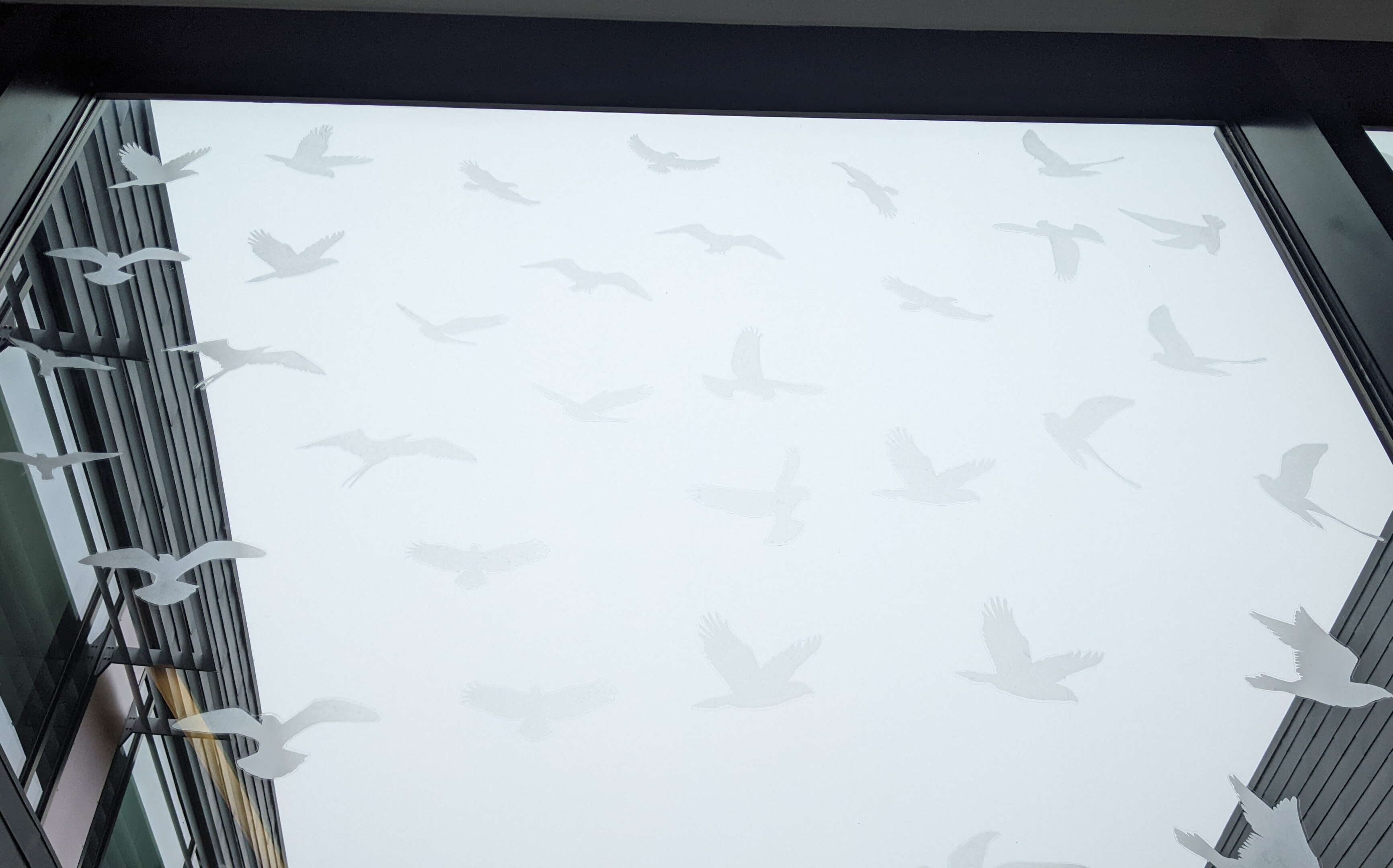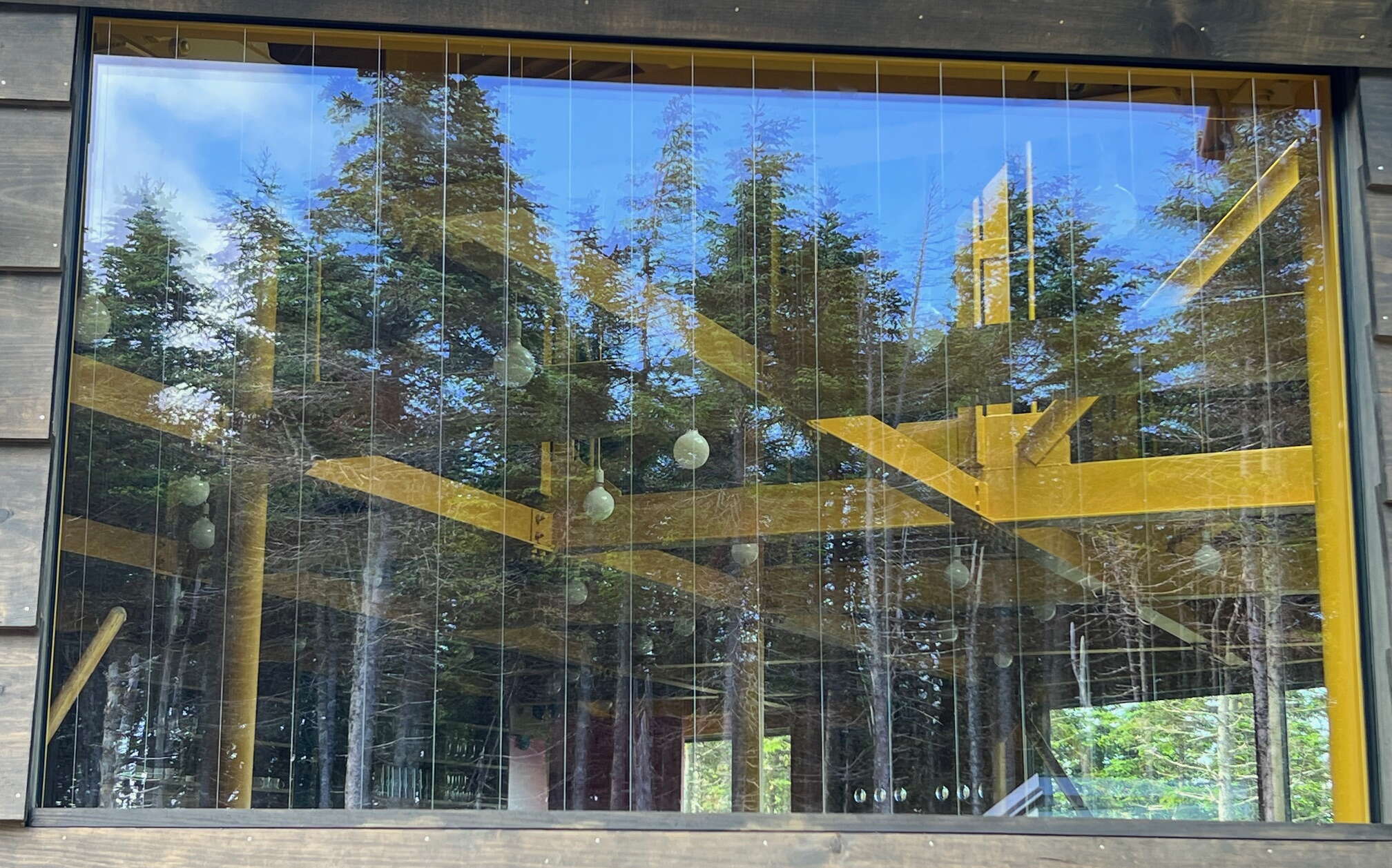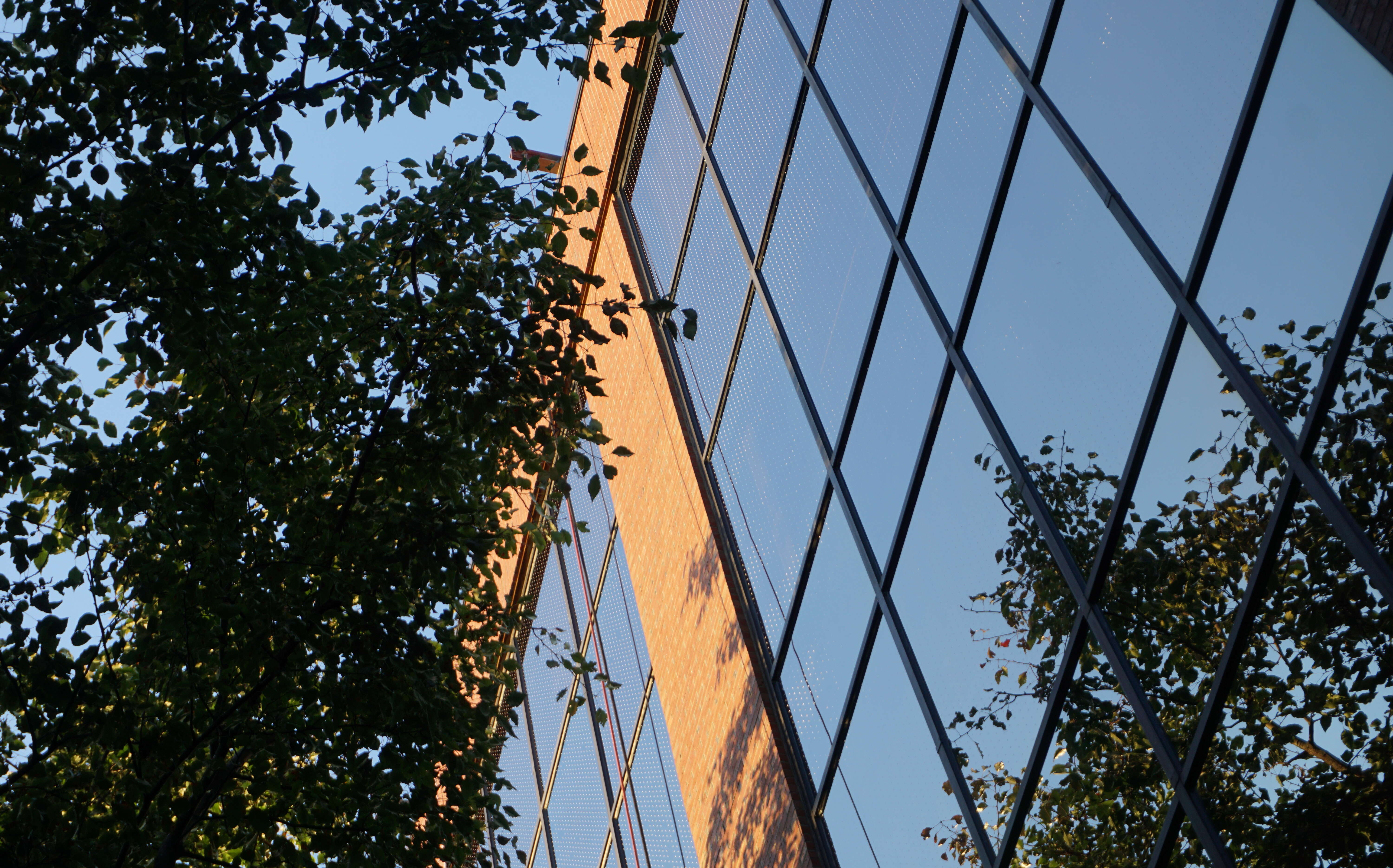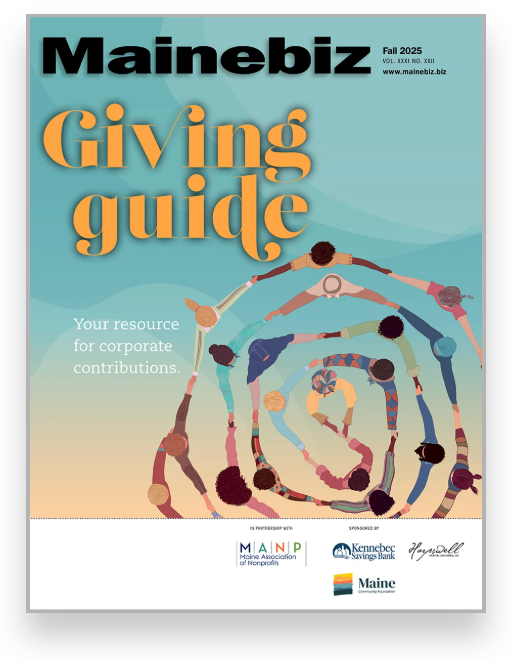
Processing Your Payment
Please do not leave this page until complete. This can take a few moments.
- News
-
Editions
View Digital Editions
Biweekly Issues
- October 20, 2025
- October 6, 2025
- September 22, 2025
- September 8, 2025
- August 25, 2025
- August 11, 2025
- + More
Special Editions
- Lists
- Viewpoints
- Our Events
- Calendar
- Biz Marketplace
Audubon teams up with architects, USM to urge businesses to add bird protections
 Photo / Courtesy Maine Audubon
L.L. Bean installed thousands of square feet of bird-safe decals at its new headquarters in Freeport.
Photo / Courtesy Maine Audubon
L.L. Bean installed thousands of square feet of bird-safe decals at its new headquarters in Freeport.
More Maine companies and residences are rolling out solutions to deter birds from flying into their windows.
But there’s much more to be done.
“It's very clear that bird strikes reduce when solutions are installed,” Nicholas Lund, advocacy and outreach manager for Maine Audubon, told Mainebiz. “At this point, though, there isn't enough adoption of solutions to say we've made much of a dent yet.”
Maine Audubon, the University of Southern Maine and the Portland Society for Architecture are partners of BirdSafe Maine, which has been working for four years to raise awareness of the bird strike problem and its solutions.

BirdSafe Maine this week announced the winners of its inaugural Bird Safe Awards, which honor companies, schools and individuals working to protect birds from window strikes. (See sidebar for full list.)
Maine companies that have taken it upon themselves to invest in bird safety include L.L. Bean and MEMIC.
L.L. Bean installed thousands of square feet of bird-safe decals at its new headquarters in Freeport.
In the Old Port, the MEMIC building, once considered among the most dangerous on BirdSafe’s Portland survey route, installed window decals and was able to reduce strikes by more than 80%.
BirdSafe Maine worked with Saddleback to design removable screens for its new mid-mountain lodge, The Nest. Employees initiated an effort to treat glass windows at Bigelow Laboratory for Ocean Science’s headquarters in East Boothbay.
Schools and universities are also taking action.
Noah Perlut and his students helped encourage the University of New England to invest in bird-safe glass for the new Ripich Commons building in 2018. Faculty at Yarmouth Elementary School have been running a BirdSafe curriculum for two years, and students wrote letters to school administrators asking them to take action on school windows, culminating in a bank of bird-safe curtains.

Several representatives from Maine's architecture and design community have played lead roles in adapting to the new and rapidly-evolving field of bird-safe architecture.
Derek and Jeannette Lovitch, owners of Freeport Wild Bird Supply, worked with Matt Maiello of Simons Architects to design and build Maine's first bird-safe residential building in Durham, according to a news release.
“Education on the issue is a fundamental challenge — and part of the reason we are honoring those who have helped so far,” said Lund.
Birds strike windows because they reflect the sky or habitat, or because glass is invisible when lit from within. Up to 1 billion birds die in the U.S. each year this way.
“A solution is anything that lets a bird know that there's a solid object there — a window — instead of the sky or habitat,” he said. “Decals are a popular and good-looking solution, but there are many others, including insect screens, ultraviolet material, mullions, temporary paint or other solutions.”
It’s easier to design a building to be bird-safe than it is to retrofit an existing building, he added.
BirdSafe has policy solutions underway. Last year the state legislature passed LD 670 An Act to Protect Birds in the Construction, Renovation and Maintenance of Public Buildings. BirdSafe has proposed a city ordinance in Portland that focuses on getting builders to design buildings to be bird-safe.
LD 670 makes Maine one of a handful of states to take statewide action on bird-safe architecture, said Lund.
“We will be working this summer to design guidelines for use in state-funded buildings” won't require retrofitting, he said.

Each year, 40,000 to 50,000 birds die in Portland after striking building windows, Lund previously told Mainebiz.
The problem can be difficult for companies, often because of the large amount of glass in some corporate buildings and the cost involved in treating large areas.
“We are not advocating for any retroactive treatment for any buildings, though we do work with companies like LL Bean and MEMIC that are willing to do so anyway,” said Lund.
Bird-safe solutions
Many buildings can be bird-safe without using any special products or glass; they just avoid having large windows or other areas of glass. Many historic buildings in Portland are naturally bird-safe since they have small, recessed windows or use antique glass, according to Maine Audubon.
Bird-safety ordinances have resulted in some criticism, with cost being a typical concern.
After consulting with BirdSafe, L.L.Bean installed about 19,000 square feet of decals on its forest-facing windows. The decals are made by a Toronto, Ontario, company called Feather Friendly. Established in 2006, Feather Friendly makes window applications patterned with markers or lines, that are applied to the outside of the window or glass curtain wall to prevent collisions by breaking up and reducing surface reflections, without impeding views from within, according to it website.
MEMIC also installed Feather Friendly solutions at its 261 Commercial St., Portland, location that, by late last year, resulted in an 82% drop in the number of dead birds from the previous season.
“Saddleback is an interesting situation,” said Lund.
There are few birds of any kind at that elevation in the winter, but many more during other seasons, including the threatened Bicknell’s Thrush, he said.
“Saddleback wanted large glass windows to showcase their views during winter, but also wanted to protect the thrush and other birds,” Lund said. “We compromised by creating seasonal, removable screens made with clear thread. These can be removed when skiiers are there in winter but re-installed when birds return.”
The glass at the University of New England consists of strips of ultraviolet material embedded in the glass.
“Most birds can see light in the ultraviolet spectrum, but humans cannot,” said Lund. “Therefore, a bird will see a UV window as a solid object but a human will see it as clear.”
He continued, “There is a lot of promise for UV technologies to produce a window that is both effective and has the lowest visual impact as possible. Drawbacks include a high expense of UV windows and that they're less effective in low or direct light, or in fog.”
It can be difficult to measure strike reduction.
“Before-and-after monitoring is really the best way,” said Lund.
Bird-safe awards
Awards for Corporate Excellence
- L.L.Bean: Installed thousands of square feet of bird-safe decals at its new headquarters in Freeport.
- MEMIC: Installed window decals and was able to reduce strikes by more than 80%.
- Saddleback Mountain: Installed removable screens for its new mid-mountain lodge, The Nest.
- Bigelow Laboratory for Ocean Science: Treated glass windows at its headquarters in East Boothbay.
Awards for Educational Excellence
- University of New England: Noah Perlut and his students helped encourage UNE to invest in bird-safe glass for the new Ripich Commons building in 2018.
- Faculty at Yarmouth Elementary School have been running a BirdSafe curriculum for two years, and students wrote letters to school administrators asking them to take action on school windows, culminating in a bank of bird-safe curtains being installed in early 2024.
Awards for Excellence in the Design Community
- Austin Smith, Simons Architects
- Julia Tate, Simons Architects
- Ed Parker, Alisberg Parker Architect LLC
- Jonathan Toews, Davies Toews Architecture
- Catherine Culley, Redfern Properties
- Danielle Foisy, Juniper Design + Build
- Timothy Lock, GOLogic
Champion for Bird Safe Policy
- State Rep. Sophia Warren (House District 29), Scarborough: Sponsored LD 670, An Act to Protect Birds in the Construction, Renovation and Maintenance of Public Buildings.
Award for Residential Excellence
- Derek and Jeannette Lovitch: Owners of Freeport Wild Bird Supply worked with Matt Maiello of Simons Architects to design and build "Maine's first bird-safe residential building" in Durham.
Bluebird Award for Bird-Safe Achievement
- Addy Smith-Reiman: Co-founded BirdSafe Maine during her tenure as executive director of the Portland Society for Architecture.
Mainebiz web partners
Related Content

The Giving Guide
The Giving Guide helps nonprofits have the opportunity to showcase and differentiate their organizations so that businesses better understand how they can contribute to a nonprofit’s mission and work.
Learn More
Work for ME
Work for ME is a workforce development tool to help Maine’s employers target Maine’s emerging workforce. Work for ME highlights each industry, its impact on Maine’s economy, the jobs available to entry-level workers, the training and education needed to get a career started.
Learn More
Groundbreaking Maine
Whether you’re a developer, financer, architect, or industry enthusiast, Groundbreaking Maine is crafted to be your go-to source for valuable insights in Maine’s real estate and construction community.
Learn more-
The Giving Guide
The Giving Guide helps nonprofits have the opportunity to showcase and differentiate their organizations so that businesses better understand how they can contribute to a nonprofit’s mission and work.
-
Work for ME
Work for ME is a workforce development tool to help Maine’s employers target Maine’s emerging workforce. Work for ME highlights each industry, its impact on Maine’s economy, the jobs available to entry-level workers, the training and education needed to get a career started.
-
Groundbreaking Maine
Whether you’re a developer, financer, architect, or industry enthusiast, Groundbreaking Maine is crafted to be your go-to source for valuable insights in Maine’s real estate and construction community.
ABOUT
NEW ENGLAND BUSINESS MEDIA SITES
No articles left
Get access now
In order to use this feature, we need some information from you. You can also login or register for a free account.
By clicking submit you are agreeing to our cookie usage and Privacy Policy
Already have an account? Login
Already have an account? Login
Want to create an account? Register
Get access now
In order to use this feature, we need some information from you. You can also login or register for a free account.
By clicking submit you are agreeing to our cookie usage and Privacy Policy
Already have an account? Login
Already have an account? Login
Want to create an account? Register











0 Comments